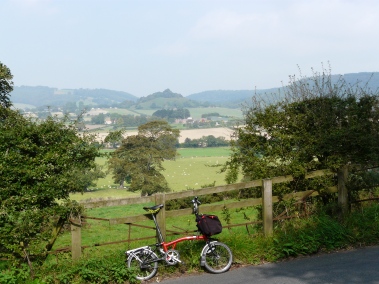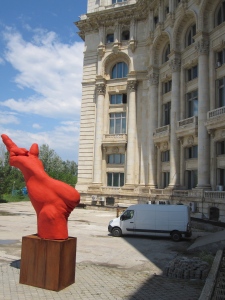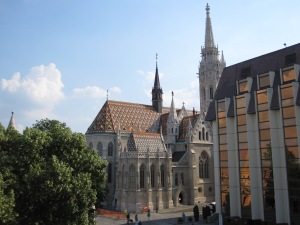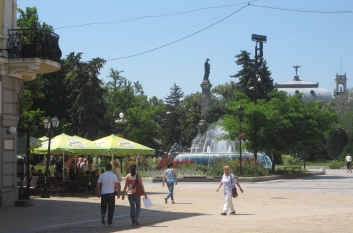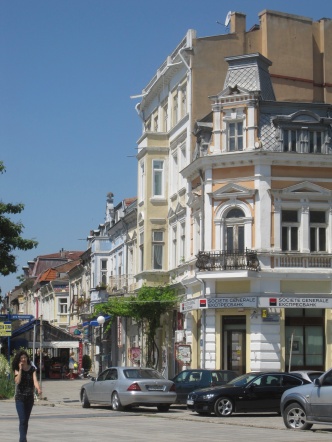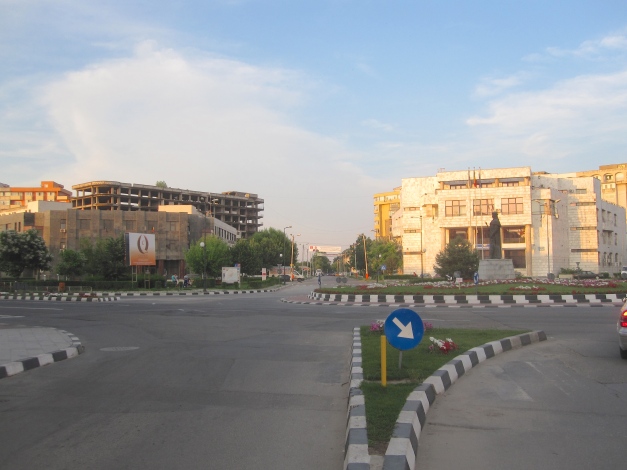My apologies to any would-be regular readers for the long hiatus between posts. This was due to an unaccustomed encounter with ill-health. However, back to normal now, which means that new posts will be as irregular and intermittent as before.
INTERMISSION
June 1, 2015Tartt’s Goldfinch.
September 16, 2014Tour de force, but was it worth it for the morals at the end : Beautiful things last; sometimes bad ends up good.
Apart from that – memorable.
A Short Moorland Ramble
September 16, 2014So, Folding bike on the bus to Helmsley then a short puff up to the junction for Rievaulx, down to the stream, across and along the mostly gentle curving foliage-covered valley-side road to Old Byland, where the structure below, of unknown utility, lurks in a hedge.
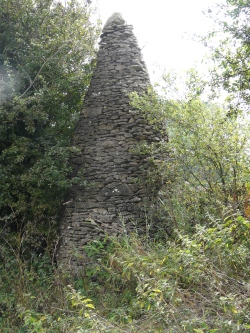 Then there’s a bridleway leading to the scarp edge. A little misty for a good photo but looking back east there was this –
Then there’s a bridleway leading to the scarp edge. A little misty for a good photo but looking back east there was this –
and west, the next photo:
 Note the field of sunflowers at almost the highest point of the Hambleton Hills.
Note the field of sunflowers at almost the highest point of the Hambleton Hills.
And beside the same track:
Descending Sneck Yate bank on a Brompton felt quite hairy, but it was worth it, not least because just beyond the view and the fine oak was the Carpenter’s Arms, Felixkirk, a gastro-pub with a well deserved reputation, which set me up nicely for the 2 miles to Thirsk and the bus home.
Some London Notes
July 25, 2014188 to the Cutty Sark
Getting on the 188 in Russell Square, where it starts, and getting off in Greenwich, just before the end of the route, gives a wonderful tour of parts of South London that my previous explorations hadn’t reached. After Waterloo Bridge and the Elephant it pretends it’s going to cross Tower Bridge but then swings towards Rotherhithe and the Surrey Docks, nearby which is the quaintly named (but presumably for a reason) Canada Water, and on to Deptford and Greenwich, And for anyone who last visited the Cutty Sark in the 60s or 70s or even 80s, it’s a wonderful new experience to do in now. It’s set on a clear roof which comes to the waterline, so you see it as if on the sea, the interior is not too cluttered but has loads of interesting stuff about the ship and its trading history, there’s nothing too offensively electronic, you can go up on deck and then back down below to walk beneath the splendidly copper-bottomed hull (and take tea, if you wish). It’s a smashing focal point on the Greenwich waterside.
River bus
Mysteriously part of the London Transport network, and even more mysteriously labelled KPMG, who I thought were bean-counters rather than part of the real world, the every 20 minutes all year early to late river bus service from the Eye and Embankment to North Greenwich with stops along the way is a wondrous thing. It would be nice if you didn’t have to queue at the ticket office even to use your Oyster card, and nicer still if you could stand on deck, but on the whole it’s a very satisfying way to get up and down river. Well-filled, from my observation, too.
Eating at Carluccios, Viennese, Gitane, Patisserie Valerie, LRB teashop,
Some nice eating experiences – Carluccios on St Pancras. Sat outside on a level with the Eurostars and under the great roof. A bit overshadowed by the hideous giants statue, but at least there’s Sir John just down the way. His waistcoat’s getting shiny – I think people rub his tummy. A tiny patisserie on Judd Street with authentic baguettes, deliciously filled; Gitane coffee and cake shop on Great Titchfield Street; a superb Viennese café in Islington
Cycling The Lower Danube. Euro Velo 6. After the cycling
July 25, 2014Next up on the way home was Bucharest. Quite drab. Difficult to find somewhere to eat either dinner or breakfast. The places we did find were excellent, though quite upmarket. Most of the city singularly uncommercialised though busy and with major traffic and parking problems.
We were struck by Ceausescu’s massive parliamentary building / palace, which now has the contemporary art museum in a small part of it. It is said to be the largest building in Europe. That museum, and the Romanian art and European Art museums were beautifully done but had almost no visitors. We outnumbered the guards about 10:1.
Then by overnight train to Budapest, which by contrast was thoroughly westernised and tourist orientated and quite delightful. The Danube even seemed a little less overwhelming here.
Must go back to Budapest. If only for the fantastic coffee and cakes.
And so back upstream, glimpsing the Danube at Vienna, Passau, and crossing it for the last time at Regensburg.
Must do that last bit to the Black Sea some time.
Cycling the Lower Danube. Eurovelo 6. Day 11.
July 25, 2014By the time we got to Giurgiu, we knew we didn’t have time to get to the Black Sea as we had to get back to our respective homes. So, having worked out the train times back across Europe we decided we could do a little city hopping. First up, the small city of Russe, formerly Rustchuk, in Bulgaria, just across the river from Giurgiu. The bridge here dates from the 50s and is showing its age – but at least the customs inspections spaced out the vast numbers of lorries so we didn’t experience the sheer terror of the Belgrade bridge or the road into Severin.
Russe was a delight. Some people have called it Little Vienna, and it does have that middle European feel, much aided on this particular day by the hot sunshine and the fact that no fewer than 3 Danube cruise ships were tied up at the quay and many of their passengers were enjoying the cafés and restaurants. We also found a tiny museum at a Roman fort near the centre of the town. A very knowledgeable custodian, who also showed us the WWII air raid shelter cut into the same site.
Patrick Leigh Fermor visited and liked this place. He too found it a welcome change from rather less westernised parts of these countries, though his rural experiences involved more roughing it than ours ever did. Also, he had to deal with the theft, and eventual return, of his rucsac in the town, which rather diverted his attention for a time.
Here we met a young couple cycling to New Zealand via the “Stans” and China. Put our little jaunt in perspective, rather. Other cyclists were merely going to Istanbul, or the Black Sea.
Cycling the Lower Danube. Euro Velo 6. Day 10
July 20, 2014Much the same as yesterday for the cycling – though there were more trees alongside the road and in long lines leading down to the distant river. The area felt slightly more prosperous, maybe because we had entered a different administrative area, or maybe because it’s nearer to the capital, Bucharest.
We arrived at Giurgiu, which was to be our final cycling destination. It’s a larger town than any we had stayed in since getting off the sleeper in Belgrade. And had some imposing buildings for the local administration – designed to be intimidating and to radiate power.
The two blocks closest to the roundabout, the brown and the white, are the unwelcoming face of local government and tax collection. What is interesting too, in this and the next picture, is the unfinished building behind. This wasn’t a construction site, it was abandoned. Not, like some we saw, after being used as factory, offices, or flats, but left unfinished. There were a couple of commercial occupiers on the ground floor, but the rest – unused for years. Contrast with the completed adjacent block of flats below.
And then, what could have been a Norwegian stave church just along the way from the previous pictures. Unfortunately it was in the grounds of a hospital so we couldn’t investigate.
We booked our train tickets to Bucharest at what is said to be the oldest station building in Romania – and very pretty it was. Having Bromptons, and making sure they were folded and covered, we had no trouble with getting bikes on trains, something we had been told was difficult if not impossible in Romania. The suggestion that you have to reserve in advance to go on a train is also, it seems, not true for local trains, though long-distance and particularly, international trains, do seem to need advance booking.
Although this was where our cycling the Danube Cycle Route finished, there is more, as we nipped across the river to the Bulgarian town of Russe (formerly Rustchuk) and then trained home via Bucharest and Budapest. See the next couple of posts, to follow.
Cycling the Lower Danube. Eurovelo 6. Day 9
July 20, 2014Day 9 doesn’t seem to have been a day when I used the camera. So here’s a word picture:
Geese, frogs, storks, goats, sheep, cows, turkeys, donkeys, horses. One wooden tyred cart. Dangerous high-fiving kids. Chances to speak English, German, French, Spanish. Old men interested in what we were doing. Coffee and coke to keep us going. Café with plastic garden chairs all split in the middle of the back. Snakes and badgers as road-kill. Lizards. Road today mostly on the ridges – Danube in distance. Large fields. Some open pasture with herds of goats, sheep, geese. Tiny frogs. Lots of electricity poles topped by storks nests. And sparrows lodging in the lower levels, chattering constantly. Storks with babies overflow the nest. Donkeys, shaggy and brown. Donkeys, old, grey. Almost all horses brown. Few cuckoos today. A little bit of fly-tipping but not as much as further west. Zimnicea, where we stopped for the night, is at the Southernmost point of the Danube. Industry and a ferry. Land of ancient bicycles and slow cycling – or new bikes woefully ill-adapted to their riders. Kids on their Dad’s crossbar. Roma kids more wrapped up. Ducks geese and turkeys all had little ones – being given lessons in road crossing.
Never sure how many guests there might be at the hotels we stay at – which nonetheless seem to have a huge staff. Are they subsidised ? How do they live ? Towns often have grand central squares ill looked-after – and really nice kids’ playgrounds and parks – but no-one cuts the grass. Temperature maybe 35 deg C at end of afternoon.
Generally, swallows, martins, sparrows, rooks, jackdaws,cuckoos, stock doves, kestrels, a buzzard (maybe) , pigeons, storks, cranes, herons, blackbirds, and larks.
Fishermen with long amateurish poles. Excellent grilled perch for dinner.
Wind steady from the West.
Cycling the Lower Danube. Eurovelo 6. Day 8
July 17, 2014
This is the most popular location for stork nests. In some villages a nest on almost every electricity pole. By this day, the eggs had begun to hatch, and the nestling’s heads poked out of the scruffy bundle of sticks. Note too, the large number of smaller birds, mostly sparrows, who have taken up residence in the lower storeys of the nest.
Scenery and villages very similar to previous days – fields full of people working, horse and donkey carts, kids wanting high 5s, old people sitting outside their houses. But also some huge fields of solar collectors, presumably pumping loads of electricity into the grid, given the bright sunshine all day. I noticed later that flat areas in Hungary and Austria have such fields too, and even one not far North of London, seen from the train on the very last leg of this journey.
Outside the villages, the fields were flat, though the roadsides were again thick with wildflowers.
After lunch in the rather lacklustre town of Corabia, where the service in one of the two cafes was so hostile we opted for the other for our meal, we cycled on to Turnu Magurele, a larger town. We stayed in the hotel, and had the following views from our room. As well as the magnificent church you can see, to its left, the kind of building which we found in almost every town and village – either half-finished, or half demolished. Side by side with well-maintained buildings. Overall, Romania seemed The Unfinished Country. New buildings unfinished, old buildings only partially demolished, and almost nowhere did we find a hotel or pension where everything in the room was unbroken – although the showers always worked and produced at least luke-warm water, it was a rare place where you could affix the shower head to the wall-fitting, or the shower curtain, if it existed, prevented the floor from flooding.

Round the front, magnificent, if slightly illusory, towers, and thunder clouds.
Oh, and more storks and their brood. Beginning to overflow the nest.
Cycling the Lower Danube. Euro Velo 6/ Day 7
July 16, 2014Lom was the one place where we saw any evidence of flooding from the recent heavy rain in Serbia. The riverside park had been recently under water and one of the landing stages had been damaged. The river here was lined by fishermen in the evening, and there were also some barges unloading at the quay. Another city where the evening activity for everyone seemed to be walking up and down the main street and through the huge communist era square. These squares were quite typical of many places we passed through, both in Bulgaria and Romania. We left Lom and almost immediately began to climb onto a low ridge which ran parallel to the Danube. At first we feared that the cobbled road which ran through two villages would continue but mercifully it changed to a better, if still not good, surface. Our reward was magnificent views north and south along the river and across to the flatlands of southern Romania.
Lom in the distance.
Looking upstream – the floodplain was clearly doing its job.
And downstream.
We did find lunch in a small town, but as so often the cafe was hidden off to the side of a sterile square.
We crossed back to Romania on a (relatively) small ferry with a (relatively) relaxed passport and Customs operation. The sign says Romania 0.5km – across the water, that is. The sun was baking and the metal deck of the ferry was hot enough to cook on, I’m sure.
A kilometre or so from the ferry landing in Romania we found good, motel style, accommodation in Bechet. Some evidence here too of EU money going in for both tourist and drainage infrastructure. The accommodation staff seemed to find the notion of guests a little surprising but they rallied to the situation and produced an excellent dinner and the usual omelette and salad for breakfast.
The most usual form of agricultural transport throughout those parts of Romania and Serbia that we visited. Almost always the 4-wheel carts had rubber tyres – we saw one with wooden/iron wheels- and usually one brown horse (the one above is unusual), sometimes two, or one or two donkeys. Often the whole family was on the seat, or an old couple.


